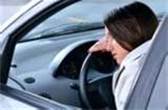Young Drivers Admit to Nodding Off Behind the Wheel
 |
16-24 year olds more likely to be involved in drowsy driving crashes finds AAA Foundation study
WASHINGTON--Nov. 9, 2012: Younger drivers are more likely to drive while drowsy according to new data presented by AAA. Based on a recent survey conducted by the AAA Foundation for Traffic Safety, one in seven licensed drivers ages 16-24 admitted to having nodded off at least once while driving in the past year as compared to one in ten of all licensed drivers who confessed to falling asleep during the same period.
These new findings echo data from a 2010 AAA Foundation study of National Highway Traffic Safety Administration (NHTSA) crash data that estimates that young drivers age 16-24 were more likely, by some 78 percent, to be drowsy at the time of the crash as drivers age 40-59. This earlier analysis also revealed that one in six deadly crashes involve a drowsy driver, making it one of the leading contributors to traffic crashes.
"Research shows that fatigue impairs safe driving, with many symptoms causing drivers to behave in ways similar to those who are intoxicated," said AAA President & CEO Robert Darbelnet. "In preparation for the holiday driving season and with many young drivers heading home for Thanksgiving break, AAA is drawing attention to this often overlooked crash risk that is a serious threat to everyone's safety on the road."
The recent analysis also found that while eight out of ten people view drowsy drivers as a serious threat to their own personal safety, many admit to driving while extremely drowsy themselves. In fact, 30 percent of licensed drivers reported having driven in the past 30 days when they were so tired that they struggled to keep their eyes open.
"Unfortunately, most drivers underestimate the risks associated with drowsy driving and overestimate their ability to deal with it--that's a dangerous combination," said AAA Foundation President & CEO Peter Kissinger.
Driving while sleepy or fatigued can significantly impact driving ability, causing slower reaction time, vision impairment and lapses in judgment. While there is no guarantee that drivers will recognize when they are becoming tired behind the wheel, signs of drowsy driving can include:
- Trouble remembering the last miles driven or missing exits and traffic signs
- Difficulty keeping your eyes open and focused
- Yawning frequently or rubbing your eyes repeatedly
- Drifting from your lane or off the road
- Daydreaming or having wandering, disconnected thoughts
AAA urges all motorists to stop driving and find a safe place to pull over if experiencing any of the drowsy driving symptoms. To remain alert and be safer behind the wheel, AAA suggests:
- Get plenty of sleep (at least seven hours) the night before a long trip
- Avoid travelling at times you would normally be sleeping
- Schedule a break every two hours or every 100 miles
- Avoid heavy foods
- Travel with a companion and take turns driving
- Avoid medications that cause drowsiness or other impairment
AAA is also highlighting the risks of drowsy driving in support of the National Sleep Foundation's Drowsy Driving Prevention WeekŪ which runs November 12-18. This annual campaign provides public education about the under-reported risks of driving while drowsy and countermeasures to improve safety on the road. For more information about drowsy driving, visit the National Sleep Foundation's drowsy driving website at Drowsing Driver.
As North America's largest motoring and leisure travel organization, AAA provides more than 53 million members with travel, insurance, financial and automotive-related services. Since its founding in 1902, the not-for-profit, fully tax-paying AAA has been a leader and advocate for the safety and security of all travelers. AAA clubs can be visited on the Internet at AAA.com.


